Rachel Carson and the Nobodies
Bob Musil, President, Rachel Carson Council
The coronavirus lock down has stilled the incessant voices of rallies, celebrities and big shots who dominate our lives. Agreeing with Emily Dickinson that it is dreary to be “somebody,” Musil returns to one of Rachel Carson’s favorite spots along the C&O Canal. He recalls Carson’s words, “One way to open your eyes to unnoticed beauty is to ask yourself, what if I had never seen this before? What if I knew I would never see it again?” Finding the beauty of wildflowers peeking out from leaf litter – spring beauties, Dutchman’s breeches, cut leaf toothwort – Musil reflects how, in the stillness, we have all begun to notice the importance and beauty of previously unseen, unsung people.
It is eerily still, like the small town without birds or sounds in the opening fable of Rachel Carson’s Silent Spring, as self-isolation sweeps across the nation, along with the corona virus. Big crowds and the incessant visibility of celebrities, sports figures, politicians and the powerful have ceased.
We walk much, our worlds shrunk to the backyard, the near neighborhood, a favorite woodland or wayside. You and I have become like Emily Dickinson, the self-isolated poet, who discovered and reveled and wrote about her garden and a rich, imaginative landscape she developed from the confines of her home in Amherst, Massachusetts.
“I’m Nobody! Who are you?” Dickinson wrote. “Are you – Nobody – too? Then there’s a pair of us! Don’t tell! They’d advertise – you know! How dreary – to be –Somebody! How public – like a frog! To tell one’s name – the livelong June – To an admiring Bog!”
I find I am not missing the Somebodies. And I am trying to learn to live, like Dickinson, without applause or admiration, or even notice, as my college lectures are cancelled, my oh-so important Washington meetings crossed off the calendar. Rachel Carson, of course, often counseled us to develop a sense of wonder, to find solace and restoration in nature, to notice even the tiniest things of beauty around us.
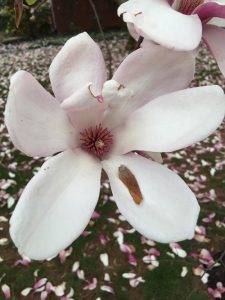
 In this spring of the virus, before the full closing of restaurants and gatherings in Washington, it was the cherry blossoms around the Tidal Basin, or the cherry trees and magnolias in Bethesda, that got the attention. But these are the spectacular Somebodies, easily noticed by car or on foot. Instead, Emily Dickinson heard a fly buzz, watched bees drunk on nectar, worshipped with a bobolink for a chorister and an orchard for a dome.
In this spring of the virus, before the full closing of restaurants and gatherings in Washington, it was the cherry blossoms around the Tidal Basin, or the cherry trees and magnolias in Bethesda, that got the attention. But these are the spectacular Somebodies, easily noticed by car or on foot. Instead, Emily Dickinson heard a fly buzz, watched bees drunk on nectar, worshipped with a bobolink for a chorister and an orchard for a dome.
As my horizons shrink and busyness declines, I am contemplating smaller and smaller beauties. Three weeks ago, I watched eagles and winter ducks and Great Blue Herons along the Potomac and the C&O Canal. Now I return, on foot, at a slow, ambling pace that allows me to stand or kneel in awe at the small, sometimes barely visible wildflowers I come upon amidst the leaf litter lining the towpath of the C&O.
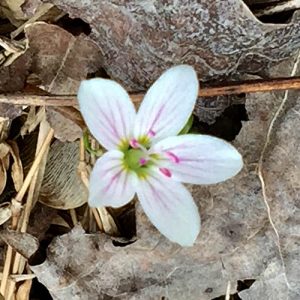
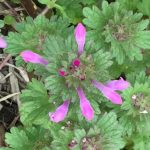 I am first welcomed back by a single spring beauty; its emergence, its desire for light and life, even its evanescence in this season of death, move me deeply here on a lonely, empty path.
I am first welcomed back by a single spring beauty; its emergence, its desire for light and life, even its evanescence in this season of death, move me deeply here on a lonely, empty path.
“One way to open your eyes to unnoticed beauty,” Rachel Carson wrote, “is to ask yourself, ‘What if I had never seen this before? What if I knew I would never see it again?’”
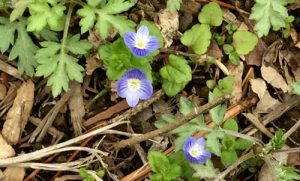 John Keats wrote that “a thing of beauty is a joy forever.” But did he mean weeds like ground ivy and downy wood mint? I am letting them grow in parts of my garden now. A weed is simply a wildflower in a place we humans do not want it. Here, I watch the wood mint opening and marvel at the tiny, orchid-like, blue blossoms of the ground ivy, no bigger than the head of a nail.
John Keats wrote that “a thing of beauty is a joy forever.” But did he mean weeds like ground ivy and downy wood mint? I am letting them grow in parts of my garden now. A weed is simply a wildflower in a place we humans do not want it. Here, I watch the wood mint opening and marvel at the tiny, orchid-like, blue blossoms of the ground ivy, no bigger than the head of a nail.
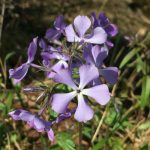 I come upon single stems of wild blue phlox, smaller, less luxuriant than those cultivated for a garden. I am taken by their petals and sepals, their hue in sunlight, one tint lighter than the periwinkle of the myrtle in my yard.
I come upon single stems of wild blue phlox, smaller, less luxuriant than those cultivated for a garden. I am taken by their petals and sepals, their hue in sunlight, one tint lighter than the periwinkle of the myrtle in my yard.
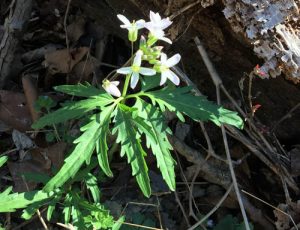 On my last trip here, I confused the beginning blossoms of spring beauties with another very small white flower, close to the ground, a cut-leaved toothwort. The toothworts have continued to grow and will reach a foot high before too long. Today, arranged before a log, they are the huge magnolia blossoms of this miniature world of beauty.
On my last trip here, I confused the beginning blossoms of spring beauties with another very small white flower, close to the ground, a cut-leaved toothwort. The toothworts have continued to grow and will reach a foot high before too long. Today, arranged before a log, they are the huge magnolia blossoms of this miniature world of beauty.
 A few wildflowers seem huge and bright, spectacular in my shrunken world. I pass only three or four golden ragwort, an “invasive” weed when noticed in a garden. They hold me spellbound. Slightly ragged, daisy-like yellow blossoms are atop a stem where others wait to explode out of small, metallic, purplish black BB’s.
A few wildflowers seem huge and bright, spectacular in my shrunken world. I pass only three or four golden ragwort, an “invasive” weed when noticed in a garden. They hold me spellbound. Slightly ragged, daisy-like yellow blossoms are atop a stem where others wait to explode out of small, metallic, purplish black BB’s.
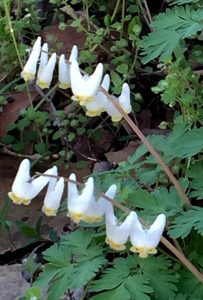
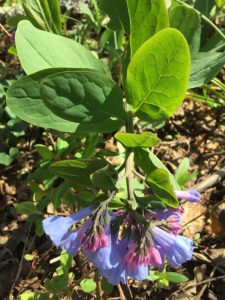 Other wildflowers have grown rapidly since I was here just twenty days before. Where there were a very few, very small, struggling Dutchman’s breeches, almost indistinguishable from the spring beauties and the cut-leaved toothworts, now the Dutchman’s breeches are visible in bigger clumps, their white pantaloons drying on the line. Virginia bluebells, that will grow to eighteen inches and spread fields of blue across the wooded floodplain between the canal and the river, have emerged from nowhere and show pink and blue flowers only several inches high.
Other wildflowers have grown rapidly since I was here just twenty days before. Where there were a very few, very small, struggling Dutchman’s breeches, almost indistinguishable from the spring beauties and the cut-leaved toothworts, now the Dutchman’s breeches are visible in bigger clumps, their white pantaloons drying on the line. Virginia bluebells, that will grow to eighteen inches and spread fields of blue across the wooded floodplain between the canal and the river, have emerged from nowhere and show pink and blue flowers only several inches high.
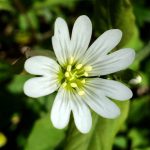
 As I wander, looking more and more closely at the leaves and twigs, singular sights appear before me. I am in awe at living organisms no larger than a quarter inch in size. A field chickweed stands alone, as precious as a pearl. Beside the towpath, a tiny scarlet jewel shines out from small tendrils and feathered leaves. Common vetch is what the field guide tells me, a plant of “roadsides and weedy places.” I am grateful that a virus has slowed me down, sharpened my vision, turned my world upside down, where the small, unnoticed beauties on the ground are important, the showy ones, the Somebodies high up, forgotten.
As I wander, looking more and more closely at the leaves and twigs, singular sights appear before me. I am in awe at living organisms no larger than a quarter inch in size. A field chickweed stands alone, as precious as a pearl. Beside the towpath, a tiny scarlet jewel shines out from small tendrils and feathered leaves. Common vetch is what the field guide tells me, a plant of “roadsides and weedy places.” I am grateful that a virus has slowed me down, sharpened my vision, turned my world upside down, where the small, unnoticed beauties on the ground are important, the showy ones, the Somebodies high up, forgotten.
I think of the small, unnoticed people, previously unseen, before the virus, whom we have all begun to notice, to appreciate, to picture amidst the silence of the Somebodies. Public health specialists, nurses, doctors, day-care workers, teachers, grocery store stockers and check out people, cooks, waiters, forklift operators, warehouse packers, truckers and delivery drivers, farmers and farm hands, the poor and homeless. I hope to hold these small wonders of wildflowers and of workers in my mind and heart long after the virus leaves us. As the poet, Theodore Roethke, has said, “In a dark time, the eye begins to see.”






